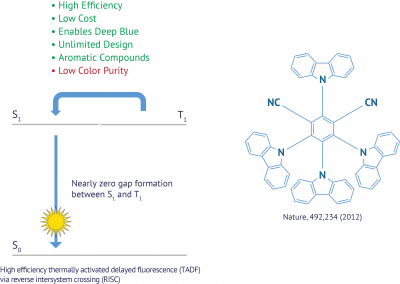What’s the difference between TADF and Hyperfluorescence?
What is TADF?
Thermally activated delayed fluorescence (TADF) is a relatively new type of OLED emissive molecule with great potential for future OLED displays as it offers high performance and low cost production.

TADF emitters set out to solve the main challenges that current generation OLED emitters face, as they are:
TADF emitters set out to solve the main challenges that current generation OLED emitters face, as they are:
- A low cost and non-heavy-metal alternative to current phosphorescent emitters
- An efficient and long-lasting soluble emitter system, suitable for ink-jet printing
- A viable road towards efficient and long-lasting blue emitters
TADF molecules have a small energy gap between the singlet and the triplet energy states (⊿Est). This enables up-conversion of excited energy from triplet to singlet spin, which provides highly efficient photonic emission from the singlet energy state in the form of delayed fluorescence.
While TADF emitters are efficient and long-lasting, the materials suffer from a wide emission spectrum, which limits the usefulness in wide color gamut displays.
What is Hyperfluorescence™?
Hyperfluorescence™ is an OLED emitting mechanism that combines both TADF and first-gen fluorescence molecules.

Hyperfluorescence™ is a 4th-generation OLED emitter technology that offers several attractive properties: high-efficiency, long lifetime, low material cost and a narrow emission spectrum. Hyperfluorescence emitters are also free of any rare metals. It holds great potential to enable next-generation OLED display panel production.
2nd-Gen (Phosphorescence) and 3rd-gen (TADF) OLED emitter technologies feature a 100% IQE, which creates the misconception that their efficiency cannot be improved.
However, both Phosphorescence and TADF emitters feature a wide emission spectrum; Hyperfluorescence™, on the other hand, combines 100% IQE with a narrow spectrum. A narrow spectrum translates into higher color purity, meaning that a display can be made with a wider color gamut. With wide-spectrum emitters, to achieve the same color purity would mean to eliminate (filter out) some of the emission, which will reduce the efficiency. With Hyperfluorescence™ emitters, this is not required and so all emitted energy can be used.
In addition to the higher color purity, a narrow spectrum emission also results in higher peak brightness – another advantage for display producers, as this can conserve power (for example in HDR displays) and enable driving the OLED with lower current that would increase efficiency and lifetime.
Differences between TADF and Hyperfluorescence™
As a start, TADF is an emitter while Hyperfluorescence™ is a hybrid system – a combination of two generations (3rd-gen TADF and 2nd-gen Phosphorescence).
In terms of performance, both achieve high efficiency, but Hyperfluorescence™ offers a favorable narrow spectrum emission while TADF suffers from wide emission.
To summarize, while Hyperfluorescence™ uses TADF molecules in its structure, it is a generation leap ahead of TADF and represents the future of OLED material technology.



